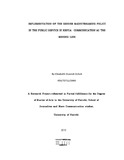| dc.description.abstract | Since the Government of Kenya made deliberate efforts to improve the state of the woman by formulating the National Policy on Gender, this study sought to find out how this policy has been communicated in the Public Service, whether it had been effective in influencing behaviour change as well as the challenges that have been faced while implementing Gender Mainstreaming. Chapter one and two of this study gives a background to disparities that exist between men and women and their implication on development. The gaps were in regard to access to employment, education and power. They two chapters also deal with definitions, the importance of a communication strategy as well as the various approaches used in communication. Chapter Three deals with Methodology. The researcher used both existing literature on the subject as well as field research through two questionnaires to collect information. One of questionnaires was administered to respondents in the public service and the other to those involved in Gender Mainstreaming at the Ministry of Gender, Children and Social Development as well as the National Commission for Gender and Development. The data was then analysed by a data analyst.
Findings, recommendations and conclusions are dealt with in Chapter Five and six. The study found that while the Policy had included communication and advocacy as one of its core targets, there wasn't evidence of deliberate support of the same outside the normal Government communication modes such as the Circular. It was also found that the mass media was least used in Gender mainstreaming efforts. Thus, the Government Circular was widely used in conveying information on Gender Mainstreaming and it had created very high awareness but modest understanding of the Gender Mainstreaming concept in the Public Service. These findings, therefore, mean that deliberate efforts have to be made to include rigorous advocacy plans within the plans of Gender Mainstreaming and to support it with adequate financial and human resources for greater success to be realised. | en_US |

